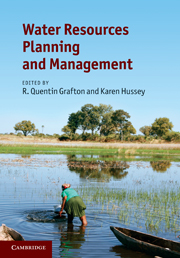Book contents
- Frontmatter
- Contents
- List of contributors
- Foreword
- Preface
- Acknowledgements
- Introduction
- Part I Understanding ‘water’
- 1 Climate change and the global water cycle
- 2 Understanding global hydrology
- 3 Groundwater and surface water connectivity
- 4 Understanding the basics of water quality
- 5 Inland water ecosystems
- 6 Water, biodiversity and ecosystems: reducing our impact
- 7 Global food production in a water-constrained world: exploring ‘green’ and ‘blue’ challenges and solutions
- Part II Water resources planning and management
- Part III Water resources planning and management: case studies
- Contributors
- Index
- References
7 - Global food production in a water-constrained world: exploring ‘green’ and ‘blue’ challenges and solutions
from Part I - Understanding ‘water’
Published online by Cambridge University Press: 05 August 2011
- Frontmatter
- Contents
- List of contributors
- Foreword
- Preface
- Acknowledgements
- Introduction
- Part I Understanding ‘water’
- 1 Climate change and the global water cycle
- 2 Understanding global hydrology
- 3 Groundwater and surface water connectivity
- 4 Understanding the basics of water quality
- 5 Inland water ecosystems
- 6 Water, biodiversity and ecosystems: reducing our impact
- 7 Global food production in a water-constrained world: exploring ‘green’ and ‘blue’ challenges and solutions
- Part II Water resources planning and management
- Part III Water resources planning and management: case studies
- Contributors
- Index
- References
Summary
Humanity faces an unprecedented challenge of rapidly growing food demands on a planet with shrinking per capita availability of sustainable water and land resources. We analyse the options for resilient and sustainable water resource supply for food production using a ‘back-casting’ approach for 2050 (assuming UN medium population), and estimations of ‘blue’ and ‘green’ water accessibility on current agricultural land including permanent pasture. Our estimates indicate that in 2050, and after accounting for climate change, there will be enough water globally to produce a healthy diet for all. But, and this is crucial, we calculate that, out of a total population of 9.1 billion, only 2.7 billion (30%) will be living in countries that might be food self-sufficient, leaving some 6.4 billion (70%) with an overall water deficit of 2150 km3 yr–1. The shortfall will have to be compensated by imports, cropland expansion, intensification of water use on permanent pasture lands, food loss reduction, or, as a last resort reduced diet expectations, or food aid. Poor and water-deficient countries – altogether hosting 3.8 billion people – will have limited import abilities due to financial constraints. Out of these, some 2.1 billion might be able to manage by reducing animal protein in their diet and by eliminating current levels of food waste. Some 1.5 billion will, however, be left with a large water deficit, and in these countries nutritional needs can only be secured by relying on food aid.
Information
- Type
- Chapter
- Information
- Water Resources Planning and Management , pp. 131 - 152Publisher: Cambridge University PressPrint publication year: 2011
References
Accessibility standard: Unknown
Why this information is here
This section outlines the accessibility features of this content - including support for screen readers, full keyboard navigation and high-contrast display options. This may not be relevant for you.Accessibility Information
- 8
- Cited by
